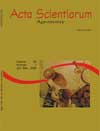<b>Mathematical modeling for drying coffee (<em>Coffea canephora</em> Pierre) berry clones in concrete yard</b> - DOI: 10.4025/actasciagron.v31i2.588
Keywords:
coffee berry, clones, mathematical model, moisture content
Abstract
The objective of this work was to obtain and evaluate the drying curves for the coffee berry species Coffea Canephora, and to fit different mathematical models into the experimental data of four clones. Coffee berries from the following clones were used: Cpafro 194, Cpafro 193, Cpafro 167 and Cpafro 180, harvested at moisture contents of 1.20; 1.32; 1.51 and 1.46 (decimal d.b.), respectively. The drying continued in a concrete yard until the moisture content of 0.10 (decimal d.b.) was achieved. Ten mathematical models cited in literature were fitted to the experimental data in order to represent the drying process. According to the results and based on the statistical parameters, it can be concluded that the Page model represents well the drying of four coffee berry clones; for the clone Cpafro180, the Verna and other models were also satisfactory in describing the phenomenon. The drying time in concrete yard for coffee berry clones Cpafro 194, Cpafro 193, Cpafro 167 and Cpafro 180, up to the moisture content of 0.10 (decimal d.b.) was 117.5 hours and the diffusion coefficient was 4.50 x 10-11; 5.17 x 10-11; 5.08 x 10-11 and 5.50 x 10-11 m2 s-1, for analyzed clones, respectively.Downloads
Download data is not yet available.
Published
2009-05-14
How to Cite
Resende, O., Arcanjo, R. V., Siqueira, V. C., & Rodrigues, S. (2009). <b>Mathematical modeling for drying coffee (<em>Coffea canephora</em> Pierre) berry clones in concrete yard</b> - DOI: 10.4025/actasciagron.v31i2.588. Acta Scientiarum. Agronomy, 31(2), 189-196. https://doi.org/10.4025/actasciagron.v31i2.588
Issue
Section
Agricultural Engineering
DECLARATION OF ORIGINALITY AND COPYRIGHTS
I Declare that current article is original and has not been submitted for publication, in part or in whole, to any other national or international journal.
The copyrights belong exclusively to the authors. Published content is licensed under Creative Commons Attribution 4.0 (CC BY 4.0) guidelines, which allows sharing (copy and distribution of the material in any medium or format) and adaptation (remix, transform, and build upon the material) for any purpose, even commercially, under the terms of attribution.
2.0
2019CiteScore
60th percentile
Powered by 

2.0
2019CiteScore
60th percentile
Powered by 



















































